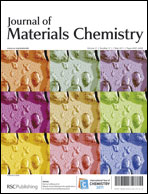Efficient deep-blue emitters comprised of an anthracene core and terminal bifunctional groups for nondoped electroluminescence†
Abstract
Four blue fluorescent host emitters with bifunctional charge transport groups appended to the 9- and 10-positions of the anthracene core have been designed and synthesized. By introducing peripheral bulky aryl-substitution groups to the emissive core, the four compounds show a decreased tendency to crystallise and have high glass transition temperatures ranging from 154 to 226 °C. The theoretical calculations reveal that the four self-hosted blue emitters possess noncoplanar structures to suppress intermolecular interaction within the films. The amorphous compounds exhibit strong deep-blue emission both in solution and the solid state. With different end-capping groups, the photophysical and electrochemical properties are tuned to produce efficient deep-blue performance with a simple device architecture. Organic light-emitting diodes (OLEDs) featuring 4 as the emitter achieve a maximum power efficiency of 2.0 lm W−1 with Commission Internationale de l'Eclairage (CIE) coordinates of (0.16, 0.10) that are very close to the National Television Standards Committee's blue standard. The well-matched energy level between the anode and 4 as well as the intrinsic good charge transport abilities results in a very low driving voltage (2.7 V), making the nondoped deep-blue electroluminescent device power efficient.


 Please wait while we load your content...
Please wait while we load your content...